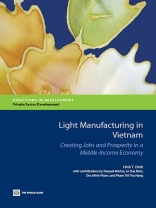Light Manufacturing in Vietnam makes the case that, if the country is to continue along a rapid economic growth path and create jobs, it must undertake a structural transformation that can lift workers from low-productivity agriculture and the mere assembly of imported inputs to higher-productivity activities. Vietnam needs to address fundamental issues in the manufacturing sector that, until now, have been masked by economic growth. The book shows that there is a dichotomy between domestic enterprises and enterprises supported by foreign direct investment. The dominant state-owned enterprises and foreign-invested firms are often not integrated with smaller, domestic firms through backward or forward links in the use of domestically produced inputs or intermediate products. Growth in the domestic light manufacturing sector has arisen from the sheer number of micro and small enterprises rather than from expansion in the number of medium and large firms. As a consequence, final products have little value added; technology and expertise are not shared; and the economy has failed to move up the structural transformation ladder. This structure of production is one of the reasons Vietnam’s rapid process of industrialization over the last three decades has not been accompanied by a favorable trade balance.Policy measures to address problems in competitiveness in Vietnam must confront the dual structure of the light manufacturing sector, while raising the value added in the industry. To that end, measures must be taken to nurture the expansion of small domestic firms, while helping these firms to achieve greater productivity through trade integration. This will require improvements in labor skills and technology and in the quality and variety of products able to compete with imports. Policies to reduce the role of the state-owned sector, promote trading companies, encourage clustering and subcontracting, and raise foreign and social networking are important in this respect. To boost the value added of its goods, Vietnam needs to integrate the supply chain in assembly activities by investing in the upstream production of the goods in which it has a comparative advantage in production and in whichit has already established a market share, such as agribusiness, garments, and wood. Unlike downstream activities, however, the production of the associated raw materials and intermediate goods is capital intensive and technology driven, and it requires skilled labor. Inviting foreign direct investment into these areas and reforming education and vocational systems are the best means to reach this goal. For this reason, the government should launch a complete review of the incentives for foreign direct investment to focus on upstream production and on bringing in capital and technical expertise, while improving labor and entrepreneurial skills.Based on this analysis, Light Manufacturing in Vietnam proposes concrete policy measures to increase employment and spur job creation by addressing sector-specific constraints. The book presents a set of practical recommendations for policy makers to identify, prioritize, and remove the most serious constraints in each sector. This book will be valuable for policy makers, entrepreneurs, workers, professional economists, and anyone interested in economic development, industrialization, and the structural transformation of Vietnam and of developing countries.
Le Duy Binh & Hinh T. Dinh
Light Manufacturing in Vietnam [EPUB ebook]
Creating Jobs and Prosperity in a Middle-Income Economy
Light Manufacturing in Vietnam [EPUB ebook]
Creating Jobs and Prosperity in a Middle-Income Economy
Compre este e-book e ganhe mais 1 GRÁTIS!
Língua Inglês ● Formato EPUB ● ISBN 9781464800351 ● Editora The World Bank ● Publicado 2014 ● Carregável 3 vezes ● Moeda EUR ● ID 5894548 ● Proteção contra cópia Adobe DRM
Requer um leitor de ebook capaz de DRM












